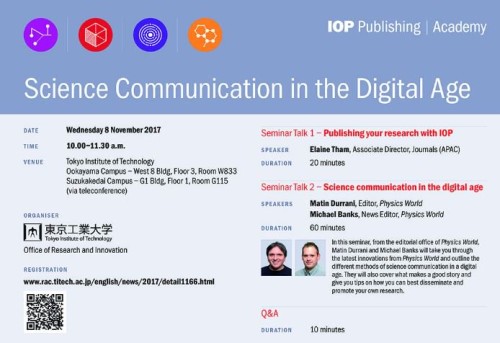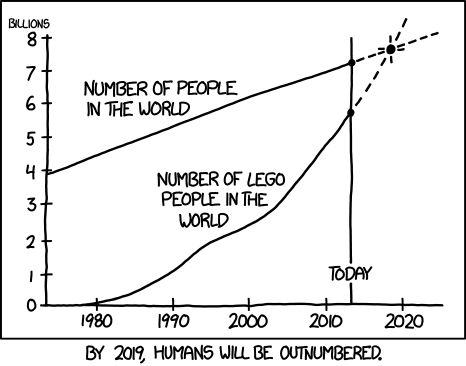Tag archives: Japan
The February 2018 issue of Physics World magazine is now out
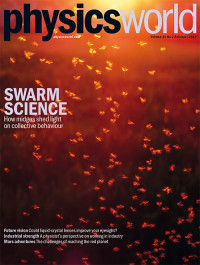 By Matin Durrani
By Matin Durrani
You’ll be delighted to know that the February 2018 issue of Physics World is now out in print and digital format.
In our cover feature this month, science writer Jennifer Ouellette discovers how tiny midges can shed light on collective behaviour in physics. You can also discover from Helen Gleeson how physicists are seeking to create liquid-crystal contact lenses – and learn from Stephen Ornes more about the technological challenges of going to Mars.
Don’t miss either our interview with the physicist who heads Japan’s leading funding agency and find out from astrophysicist Elizabeth Tasker about her experiences as an overseas scientist in the country.
And our veteran North America correspondent Peter Gwynne assesses the impact that Donald Trump has had on US science, one year into his presidency.
Remember that if you’re a member of the Institute of Physics, you can read the whole of Physics World magazine every month via our digital apps for iOS, Android and Web browsers.
Let us know what you think about the issue on Twitter, Facebook or by e-mailing us at pwld@iop.org
View all posts by this author | View this author's profile
Applied physics and Japan’s ageing population
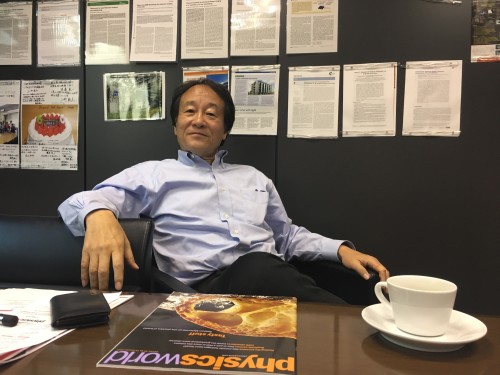
Keeping giong: Satoshi Kawata from Osaka University remains active despite having just officially retired. (Courtesy: Matin Durrani)
By Matin Durrani in Osaka, Japan
By most measures, Japan is one of the wealthiest nations in the world. Depending on which criterion you use, it’s either the third or fourth biggest economy on the planet. Much of that success is built on the country’s prowess in science and technology, which have supported numerous hi-tech giants of the corporate world.
Still, not everything is rosy in the Japanese garden. After the post-war boom years, the economy began to slump in the early 1990s and has picked up only slowly since then. To make matters worse, Japan has also had to contend with rising social-security costs to support an ageing population. Plummeting birth rates and steadily rising death ages mean that Japan’s population has fallen by just over 1% since 2010 to 126 million.
I was thinking about such matters yesterday as I walked through a shopping mall in central Osaka on my way to meet applied physicist Satoshi Kawata from the University of Osaka. Okay, it was a weekday lunchtime and this is just one data point, but there sure were lots of pensioners out shopping. I was also surprised to see a guy selling The Big Issue – the magazine that supports homeless people who want to make a living. I’d not seen any inkling of poverty in the country up to that point.
View all posts by this author | View this author's profile
When will Japan get its next physics Nobel prize?
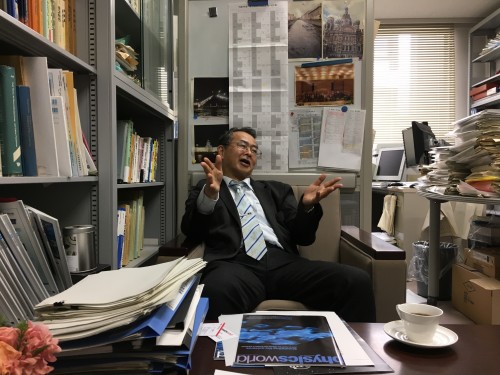
Thirteen and counting: Hikaru Kawamura wonders when Japan will get its next Nobel Prize for Physics.
By Matin Durrani in Osaka, Japan
Hikaru Kawamura, president of the Physical Society of Japan (JPS), handed me a brochure as we sat down in his office on the fifth floor of the Department of Earth and Space Science at Osaka University. Inside it were photographs of the 13 Japanese physicists who have won the Nobel Prize for Physics.
It’s an impressive list of people, starting with Hideki Yukawa, who won the 1949 prize for his theory of the nuclear force, and going all the way up to Takaaki Kajita who shared the 2015 prize for detecting atmospheric neutrino oscillations at the Super-Kamiokande underground lab. (They’re all men, of course, but that’s another story.)
However, Kawamura admitted to me during our 90-minute discussion, that he is “not optimistic” that Japan will be as prolific in terms of Nobel prizes in the future. Most Nobel laureates usually (though admittedly not always) win their awards for work done 20-30 years ago. So with Japanese physics these days being, as Kawamura puts it, “not so popular as it used to be”, how long will Japan have to wait for its next physics Nobel prize?
View all posts by this author | View this author's profile
How to get your paper noticed
By Matin Durrani in Tokyo, Japan
For physicists, doing research is only the start of the game. With thousands of papers published each year, how do you make sure your latest work stands out from the crowd?
If you’re an established academic, your peers will already know who you are and, provided you can continue getting your papers published in the top journals, your career will carry on hitting the high notes . But if you’re less experienced in the research game, then a good dose of publicity in the mainstream media can give you a great head start – and thankfully the online world can help hugely.
That was the message of a seminar “Science communication in the digital age” given today at Tokyo Institute of Technology by me and my IOP Publishing colleagues Michael Banks (Physics World news editor) and Elaine Tham (associate director for Asia-Pacific). Attended by about 40 students, science communicators and university administrators, the seminar was opened by the president of Tokyo Tech Yoshinao Mishima.
View all posts by this author | View this author's profile
RIKEN celebrates its centenary

Cool stuff: these liquid-helium tanks are used to chill the superconducting magnets at RIKEN’s accelerators in its Radioactive Ion Beam Facility. (Courtesy: Matin Durrani)
By Matin Durrani in Wako, Japan
It’s funny where chance encounters can lead.
Earlier this year, I was at a reception for science journalists at the Fenway Park baseball stadium in Boston, US, when I bumped into Jens Wilkinson, who works in the communications team at RIKEN – one of Japan’s biggest research institutions. He encouraged me to visit the lab, which was founded 100 years ago, should I ever find myself in Japan.
And so here I was at RIKEN’s headquarters in Wako, just north of Tokyo, on day two of my trip to gather material for the upcoming Physics World special report on Japan. Wako is home to the largest of RIKEN’s seven campuses, which together employ almost 2000 researchers.
Apart from celebrating its centenary this year, which included an event in downtown Tokyo with none other than Emperor Akihito, RIKEN has been in the news for its discovery of element 113. Created at the RIKEN Nishina Center for Accelerator-Based Sciemce by smashing zinc nuclei into a bismuth target, the element was last year officially named “nihonium” (Nh).
View all posts by this author | View this author's profile
Why money is tight for Japanese science
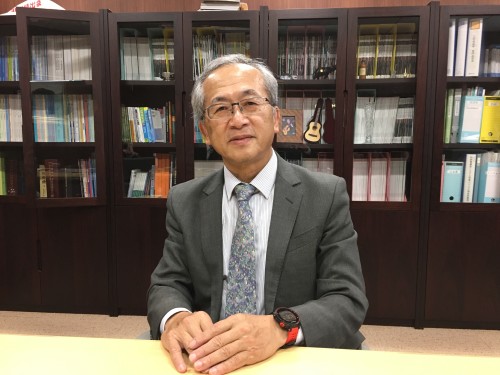
Money matters: Yasuhiro Iye is an executive director of the Japan Society for the Promotion of Science. (Courtesy: Matin Durrani)
By Matin Durrani in Tokyo, Japan
“Budget.”
That was the one-word answer from Yasuhiro Iye, when I asked him what was the most important thing on his mind as executive director of the Japan Society for the Promotion of Science (JSPS).
The society, which was founded in 1932, is responsible for funding researchers in Japan across all sectors of science, engineering and humanities. In 2015 the JSPS distributed about ¥260bn (about $2.27bn) in grants, which are awarded competitively through a rigorous peer-review process, with physicists receiving roughly 15% of the total.
It might sound a lot of money, but as Iye points out, the JSPS’s total budget has been pretty static in recent years. Money for science, Iye admits, is not as generous in Japan as in the past, which he blames on rising social-security costs to deal with the growing number of old people. “The Japanese government budget is constrained by the cost of an ageing society,” Iye says.
View all posts by this author | View this author's profile
Konnichiwa Japan
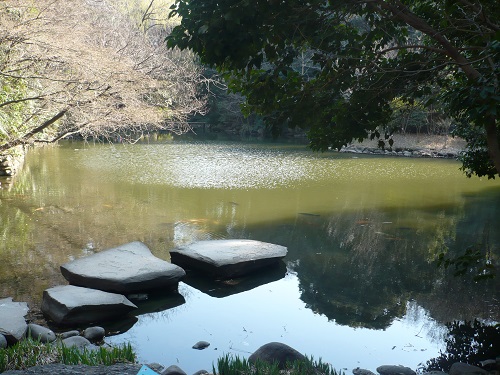
An area of tranquility at the University of Tokyo (Courtesy: Michael Banks)
By Michael Banks
Suitcases packed, Matin Durrani and I will be travelling to Japan over the weekend for a week-long road trip that will see us heading to Tokyo, Osaka, Kyoto and Kamioka.
It’s a busy schedule that includes meeting with senior policy-makers and visiting a number of high-profile institutes.
The main purpose of our visit is to gather material for a special report on Japan that will be published in February 2018 (for this year’s reports on China and the US see here and here).
View all posts by this author | View this author's profile
Radiation levels near Fukushima, trust in science and fun with correlations
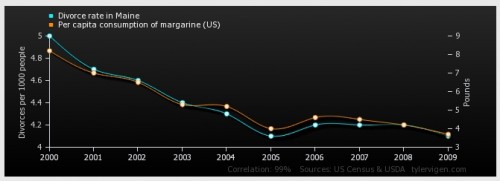
Do divorcees eat more margarine? Or does the butter substitute break up marriages? (Courtesy: Tyler Vigen)
By Hamish Johnston
This week’s Red Folder begins in Japan, where the 2011 disaster at the Fukushima nuclear power plant continues to cause misery for the 100,000 or so local people who still cannot return to their homes. But who is to blame? Writing in World Nuclear News, Malcolm Grimston of Imperial College London argues that radiation levels in much of the current exclusion zone are no higher than natural levels in other parts of Japan – and much lower than natural levels in some other populated regions worldwide. Grimston concludes that “an overzealous infatuation with reducing radiation dose, far from minimizing human harm, is at the heart of the whole problem”. His article is called “What was deadly at Fukushima?”.
Grumpy astronauts, LEGO overpopulation, videogame quantum mechanics and more
By Tushna Commissariat
This week, the Red Folder seemed filled to bursting with amusing and captivating news stories from around the web about physics. To start off, this rather hilarious and candid account of the Apollo 7 mission on the Discovery News website. I will not give too much away and let you read the story yourself, but suffice to say that having a rather bad cold while in space sounds dreadful and is bound to make the best of us quite grumpy – and I am sure the Apollo 7 crew would agree with me!
View all posts by this author | View this author's profile
Japan 101
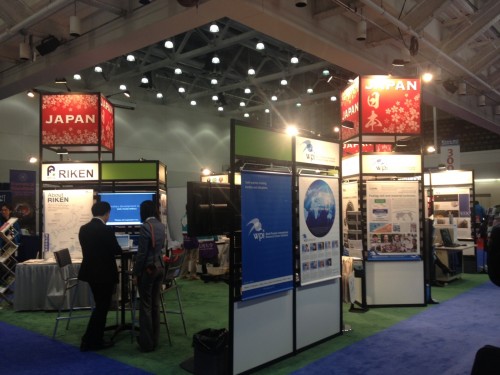
Stand from Japanese research bodies at the 2013 AAAS meeting.
By Michael Banks in Boston
There is certainly a big presence from Japanese research bodies at the 2013 AAAS meeting in Boston.
In the exhibitors’ hall, the World Premier Institutes (WPI), RIKEN and the Okinawa Institute for Science and Technology all share a large central stall plugging their research and facilities.
Indeed, this presence may well be part of Japan’s drive to increase the number of foreign researchers and students in the country by actively highlighting its top research and facilities, a topic Physics World touched upon in a special report published last September.
View all posts by this author | View this author's profile
